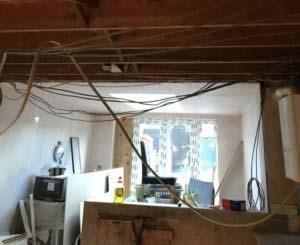Noise in the Workplace
Guidance for the employer
23,000 workers reported hearing problems between 2015/16 and 2017/18 (HSE Statistics). Noise can also be a safety hazard, interfering with communication and making warnings harder to hear and is often cited in stress complaints as a health and safety issue.
Noise at work is a problem for many companies so this week I thought that I would look at the topic and guide employers as to their duties.
Does your business have a noise problem?
There are a number of questions you should ask to determine whether you have a noise problem in your business:
- Is your industry noisy, e.g construction, demolition or road repair, entertainment, plastics processing, engineering, textile manufacture, pressing or stamping, paper or board making or canning and bottling?
- Are noisy powered tools or machinery used? – even short periods of high noise exposure can cause hearing damage.
- Is noise intrusive –e.g like a busy street, a vacuum cleaner or a crowded restaurant – for most of the working day?
- Do employees have to raise their voices to carry out a normal conversation when about 2 metres apart for at least part of the day?
- Is noise made due to impacts, such as hammering, drop forging, pneumatic impact tools, or explosive sources such as cartridge-operated tools and detonators?
What are the action levels and limit values?
At certain limit values specific action must be taken related to:
- the levels of exposure to noise of your employees averaged over a working day or week
- the maximum noise (peak sound pressure) to which employees are exposed in a working day.
| Lower exposure action values: |
|
| Upper exposure action values: |
|
| Levels of noise exposure which must not be exceeded: |
*sound pressure of 140 dB. |
Employers must assess the risk to workers’ health and provide them with information and training at 80 dB(A) and must provide hearing protection and hearing protection zones at 85 dB(A) (equivalent continuous daily exposure or weekly average exposure varies markedly from day to day).
Prevention is better than Cure
Control methods or noise reduction techniques include:
using a different, quieter process or equipment, e.g. replace whatever is causing the noise with something less noisy; instituting a low-noise purchasing policy for machinery and equipment
introducing engineering controls: avoiding metal-on-metal impacts, fitting silencers to air exhausts and blowing nozzles
modifying transmission routes for noise, e.g. erecting enclosures around machines to reduce the amount of noise emitted into the workplace or environment
designing the workplace for low noise emission, e.g. keeping noisy machinery out of areas where people spend most of their time
When should hearing protection be used?
Ear protection is a last resort where other methods of removing the risk from noise have been introduced and there is still a problem.
DO:
make sure the protectors give enough protection; below 85 dB(A) at the ear, to do this they need to be selected having regard to the level and type of noise exposure and suited to the individual
select protectors which are suitable for the working environment; consider comfort and hygiene
think about how they will be worn with other protective equipment (e.g. hard hats, dust masks and eye protection)
provide a range of protectors so that employees can choose ones which suit them
arrange audiometry testing where appropriate.

You need to make sure that employees use hearing protection when required to and are trained in how to use the equipment and in the hazards of noise exposure.
Noise risk assessments should be carried out by a competent person and take into account the HSE’s five steps of risk assessment and document the estimated noise exposure and the control measures required.
Case law
A company was fined £15,000 for failing to protect the workforce from excessive noise. The court heard that the factory had not made a suitable assessment of noise between 2006 and 20013. Noise levels became excessive from 2008 when a third machine was added to the production process. Levels reached between two and three times higher than the maximum allowed. Hearing protection was not introduced until 2013. There should also have been a surveillance programme for noise exposure for affected workers
Legislation and guidance
The Control of Noise at Work Regulations 2005 requires employers to prevent or reduce risks to health and safety from exposure to noise at work and requires employers to:
- assess the risks to their employees from noise at work
- take action to reduce the noise exposure that produces those risks
- provide employees with hearing protection if noise exposure cannot be reduced sufficiently by using other methods
- make sure the legal limits on noise exposure are not exceeded
- provide employees with information, instruction and training
- carry out health surveillance where there is a risk to health.
Help available from The Wilkins Safety Group Ltd
Here at the Wilkins Safety Group we can help clients with:
- Online training in areas such as Protection against the Effects of Noise
- WSG Guide on Control of Noise at Work Regulations 2005
If you would like any further help or support, please please contact us by phone 01458 253682, email [email protected] or via our Facebook page or by Twitter.
Save Money on Your Online Training
If you are a company that will need quite a few of your staff trained using these courses, you may want to take advantage of the fact that you can pre-buy the training credits at a bulk rate.
This will allow you to buy the credits at a discounted rate to be used at your convenience. There is no limit on the time it takes to use the credits and 1 credit = 1 training course.
For companies that know they will need over 5 in a year but not all at the same time this automatically starts reducing your costs.
To buy in bulk simply click on the bulk credits button and purchase the number you will require. Once you have paid for your courses you can utilise them at your leisure and fit them into your staff training requirements.
If you have any questions, please contact us and we will be happy to advise.
What is the cost of these courses?
Companies will be able to buy credits. Each of these credits will allow 1 allocated person access to 1 course. The cost of these credits will reduce based on the number of credits purchased. See pricing chart below:
| No of credits | 1-5 | 6-10 | 11-20 | 21-30 | 31-40 | 41-50 | 51-75 | 76-100 | 101-150 | 151-200 | 201-250 |
|---|---|---|---|---|---|---|---|---|---|---|---|
| Cost of credit | £19.99 | £17.99 | £16.99 | £15.99 | £14.99 | £13.99 | £12.99 | £11.99 | £10.99 | £9.99 | £7.99 |
Remember – There is no limit on the time it takes to use the credits
NHS trust fined £80k
NHS trust fined £80k after mental health patient fell from roof
An NHS trust has been fined £80,000 after one of its patients fell from the roof of a ward, despite it being warned about its potential danger in 2011. 
The patient climbed on to the roof of Applewood Ward in Swindon in 2016. He fell off and was seriously hurt, after refusing to come down for 11 hours. The patient broke his leg and fractured his skull and jaw in the fall.
Avon and Wiltshire Mental Health Partnership (AWP) was fined £80,000 at Taunton Magistrates’ Court, after pleading guilty to an offence of failing to provide safe care and treatment resulting in avoidable harm to one patient and putting others at serious risk of avoidable harm at a hearing in May.
The trust said it had made significant changes to improve.
An AWP spokesman said:
“We are continuing to work with NHS England to ensure that funding is made available for further improvement works needed.
“In the meantime we are carefully planning care and managing risk of harm on a patient-by-patient basis.”
The Care Quality Commission brought the prosecution to court.
Deputy Chief Inspector of Hospitals Dr Paul Lelliott said:
“Unfortunately, this was not an isolated incident – but part of a wider failure to deal with concerns over safety as they arose.
“The trust had failed to make basic improvements to protect the people in its care, despite having been aware of the dangers for years.
“They ignored clear evidence from their own reports on safety and as a result a patient suffered serious injury.”
He added:
“I hope this case will serve as a warning to any other providers.”
Gas work ‘negligence’ leads to fines
A building company and its director have been fined for unsafe construction work around a domestic gas boiler which resulted in a gas escape.
MD Building Contractors Ltd was contracted to undertake construction work at Brooklyn Avenue, Aston, Birmingham, between 26 July and 28 August 2017. The work  was an extension to the kitchen.
was an extension to the kitchen.
The HSE’s investigation found that prior to the work commencing, a pre-existing gas boiler had been located in the kitchen with its flue going out of the rear wall. During the work the original flue outlet was removed, and an external wall was built around it. This had the effect of completely enclosing the flue inside the wall with no direct external exit point for the boiler to safely vent outside.
As a result the family of six living in the house were exposed to the risk of inhaling the products of the boiler burning, including Carbon Monoxide (CO).
Manjit Singh Dhaliwal (Director) of Manor Road, Halesowen pleaded guilty to breaching Section 37 of the Health and Safety at Work etc Act 1974. He was fined £2,000 and ordered to pay costs of £431.50.
MD Building Contractors of Oak Road, Oldbury pleaded guilty to breaching Gas Safety (Installation and Use) Regulation 8(3). The company was fined £16,000 with costs of £513.10.
Speaking after the hearing HSE Principal Inspector Tony Mitchell said:
“Every year, around seven people die from CO poisoning caused by gas appliances and flues that have not been properly installed, maintained or that are poorly ventilated.
“Manjit Singh Dhaliwal was negligent in his duties as sole director to ensure that during refurbishment of the property that existing gas fittings were not adversely affected.
“All gas work must be done by registered Gas Safe engineers to ensure the highest standards are met to prevent injury and loss of life.”
Remember
Unlike other organisations who send out newsletters giving you a little titbit of information, then stating that if you want to follow the full link or read the full story or get more information you must pay to subscribe to their service.
- Our newsletter service is FREE,
- The links we supply are FREE,
- The helpline advice is FREE.

If you find this newsletter service of use and you think others might also find it useful, then kindly pass it on and ask them to subscribe for free, so they can continue to receive it in their own right.
Also contact us if you have a particular health and safety subject or question you would like covered
If you have any queries on any health and safety matter, please contact Jon Wilkins on 01458 253682 or by email on [email protected]


